One of the great things about a pit mine is that every step of the mine has plenty of level area to park on - with no rock stacking required. Plus, we'd somehow - accidentally - chosen a spot that was essentially windless, the wall behind us sheltering us from the westerly winds.
Exploring into mine adits, shafts, etc. is not safe. I joke around about that a bit in this story, but I just want to be clear: Stay out, stay alive.
The Iron Age Mine

Also - completely by accident, given that it'd been pitch black when we arrived - we'd arranged ourselves to have a nice view once day broke.
Having gone to bed relatively early, I woke up a few minutes before my alarm and half an hour before sunrise. Not knowing how far we were from the edge of this big hole in the ground, I wanted to be sure to have enough time to find a good place to snap a photo before the sun crested the horizon, casting dark shadows into the pit.
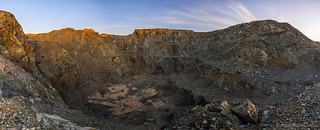
After taking a few shots from vantage points, I ended up liking this one the most, with the sun just dusting the top of the walls.

There wasn't much in the way of old structures left on site. This concrete ore bin (?) was about all we found.
It wasn't long after sunrise that Mike @mk5 was up and about as well. Somehow he'd managed to stay warm, comfortable, and cozy in his passenger seat all night - a feat that continues to boggle my mind - soon we were stowing camp in order to get an early start on the day. And our first order of business was to investigate the bottom of the big pit atop which we'd parked.

The Tacomas could only make it so far.
Consisting of an iron ore deposit that was claimed prior to 1900, patented in 1904, and exploited between the 1930's to the 1960's - before the Surface Mining and Reclamation Act of 1975 - the Iron Age Mine sits on 100 acres of land that is now primarily owned by the Bureau of Land Management (BLM). Thirty-four (34) acres are private.
As of 2022, U.S. Iron confirmed the company’s plans to reopen the mine under Iron Age LLC, and the San Bernardino County Planning Commission has approved a plan to remove un-reclaimed iron ore tailings at the old Iron Age Mine, returning about 70 acres of disturbed land back to natural habitat in about 20 years.
Previous miners only harvested the highest-grade ore, but an estimated 12 million tons - with an average of 62% iron - remains in the tailings that were left on site. Iron Age LLC will be placing a processing plant on site to crush, screen and magnetically separate the rock material, harvesting ore having an iron content higher than 60% and returning the remainder to the mine.
Iron Age Mine owners to pull out ore, close historic site
Jené Estrada, Hi-Desert Star | Jun 29, 2022

Concentrated iron ore.
There wasn't really that much at the bottom of this mine, and after a little horsing around with a recalled fire extinguisher that Mike hadn't returned in the recall window, we were back in the trucks and headed west toward the heart of the Dale Mining District. It would be - I realized as the day wore on - a tireless trek from one mine to another.
So. Many. Mines.
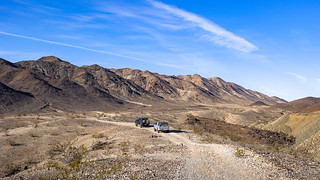
Time to explore! (You can see the edge of the Iron Age tailings piles in the lower right.)
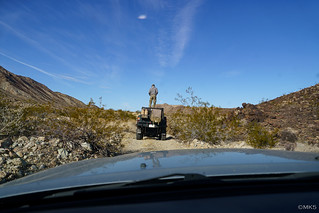
C'mon man, you're holding us up.
Two Mines on the Way to the O.K. Mine (the "3M" and Vail Mines)
With a name like "O.K.," you can't expect much from a mine, and this one delivered on that expectation. This was one of the larger - at least, by land area, and to our untrained eyes - mines that we checked out. Also, Mike had spotted a nearby headframe on satellite imagery and given that standing structures are a relatively rare find in the Dale area - given its "free-for-all" status as BLM land - we knew we had to check it out.
Of course, first we had to get there. A process that should be easy - given the relatively short distance, certainly no more than 6 miles - between the Iron Age and OK mines, we were the guys you call when you need to stretch those miles into hours. Frankly, this was probably my fault since I'd somehow ended up in the lead again, but Mike was nice enough to humor me as I stopped at claim markers, random rocks on the side of the road, and the odd active claim that still sprinkle the landscape.

One of the more interesting stops along the way was at an active mining claim registered to the 3M Group, according to the paperwork posted on site.


From the highly technical equipment, it's my guess that this is not the 3M that makes industrial products.
After covering the first three miles in a blistering 50 minutes, I offered Mike the opportunity to swap positions in our caravan. He did not refuse and soon we were covering ground at a much more reasonable speed. Or at least, he was; I kept falling behind as I stopped to take more photos.

Desert hills.

This section felt a little tippy for both of us. Mike's inclinometer said it was 26.5°. Reminded me of the time I slid sideways down a hill in Anza-Borrego.
Twenty minutes after changing leaders, we arrived at - what we thought at the time was - the O.K. Mine workshop. Turns out that this is actually the old mill from the Vail Mine. Pulling up from below, it looked pretty cool.
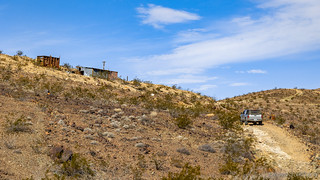
At the time, we thought we'd finally made it to the O.K. Mine. We hadn't.

Modern visitors haven't been all that respectful of the Vail Mine's Mill.

Chuck Conn, 1984 - likely one of the last to work these veins.
After poking around the workshop and nearby ore bin for a bit - and chatting with a few guys filming some sort of documentary about the district - it was time to head over to the headframe Mike had found, as well as the main workings of the O.K. Mine.

The headframe Mike had marked on the map.

1950s era headframe.
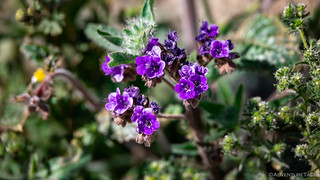
Spring is coming!
The O.K. Mine
The O.K. Mine was established in 1890 by John Burt and F. J. Botsford who worked the mine until 1899, eventually selling it to the Seal of Gold Mining Company. With the next few years, the mine became one of the most productive gold mines in the Dale district and contributed to the shifting of Old Dale townsite - 10 miles to the north - to New Dale, just a couple miles west of the mine.
At its peak, the mine had a ten-stamp mill and two 800-foot shafts, generating more than $200,000 in gold (worth between $5-7M as of 2023). Water was piped in 10 miles from Dale Lake.
Mining at the site continued up the time of the Second World War when the mine was temporarily closed for the war effort. Since then, mining has occurred on and off until the 1980s when the site was finally abandoned.

At the old mill site, plenty of tailings and waste rock piles covered the hillside and wash. Amazing what folks will do for a bit of the shiny stuff!

Colorful rockwork.

Today's residents, as colorful as the ground over which they scurry.
After a quick lunch - kibble-O's for me, and ham-on-hawaiian rolls for Mike - we poked around to see if we could find an adit to explore but didn't turn anything up and decided that we might as well try to visit one or two - or three or four - more mines before Mike had to take off towards home.
Apparently, a vacation to Hawaii with his wife was just so much more important than exploring some run-down mining remains. 

Off we go, on another rocky road.

Falling behind quickly.
The Gold Rose Mine
With our sights set on the Gold Standard Mine, we headed south. Mike - keeping one eye on the clock, and claiming that "by heading south, I'm technically on my way home," - came over the radio as he passed the remains of the Gold Rose mine, to suggest that we just drive by.
Um, no?
With no truck to park in his path - and recognizing that he was actually in a bit of a rush - I complained loudly in my radioed response and let him know that I'd catch up.

Bye Mike!
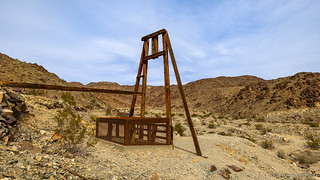
An old, small headframe over the 200-foot vertical shaft at the Gold Rose Mine.

A couple old concrete buildings and associated rockery were the most interesting artifacts at this site, which was clearly a favorite camping area for today's explorers.

When your cabin is concrete, you don't even need a wood stove, a hood and a corner will do just fine!

Don't know what this says, but it's pointing at YOU!

Behind one of the cabins, a small stash. Strange.
In the end, it was probably a good call - but don't tell him that I said so - for Mike to just continue on. This place was pretty well picked over, and while sort of neat in that it wasn't the typical collapsed wooden cabin, it was rather sterile from an historic perspective.
The Gold Standard Mine

Wait for me, I'm coming!
The road up to the Gold Standard Mine - at least via the bottom-of-the-wash route that we'd choosen - was really the road up to the Brooklyn Mine, and let me tell you - it was in rough shape. Even having stopped for ten minutes to poke around at the Gold Rose Mine, I saw Mike as he arrived at the tailings pile just a couple miles away.

As we approached the mine, we passed this old truck was probably used to haul ore to a nearby mill, as there didn't appear to be one on site.

Pretty nice location looking over Pinto Basin.

Up above the adit, a vertical shaft and rather flimsy frame likely accessed the main ore body.

Time to check out the adit!
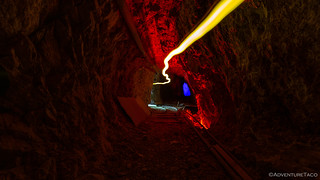
Watch out for the ghost train.
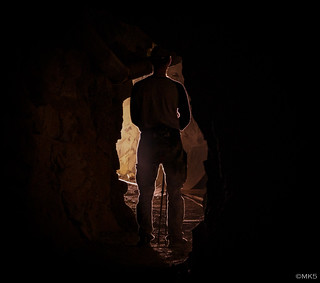
I like how Mike captured the glowing outline of my angelic halo. Usually, it's quite difficult to see. 
After looking around in the adit at the Gold Standard, it was getting on 2:00pm. Having let his wife know that he'd be headed home around noon - a fact that Mike continued to reiterate he was doing since we'd been headed south - Mike starting stowing his gear for the mad dash home and pointed me in the opposite direction to check out the Brooklyn and Los Angeles mines, a little further up the canyon.
It didn't take much more than a hint for him to make a minor, 180 degree, adjustment to his southerly route, in order to follow me up the final mile of road to the Brooklyn.
The Brooklyn Mine
It took only a few minutes to reach the Brooklyn, and as soon as we did, Mike knew that it was in his best interest to simply continue on - up and over the ridge and past the Los Angeles mine without stopping - in order to salvage his Hawaiian holiday.

I couldn't blame him. Bye Mike!
Established in the late 1800s by H.B. Botsford, the mine was sold to the Brooklyn Mining Company in 1899. Consisting of 14 claims, water was piped in from Cottonwood Springs, allowing the onsite mill to operate until the early 1940s, though mining declined after 1916 when the ore body began to run out.
Today, an old rock cabin is clearly the highlight for folks who come through, with dollar bills tacked up around the place, each with a name. I suppose that once there are enough of them, they are conveniently cleaned up by a visitor, keeping the place reasonably clean.


Nylon rope on the hot chimney. Seems safe. (left) | A guest book and some dollar bills round out the decor. (right)

The front porched offers travelers a shady place to sit in the summer.
To me though, it was the wooden ore bins a little further up the wash that caught my attention. With light pink tailings spilling out and down the wash - a sure sign that there was once a crushing mill and cyanide leaching operation going on here - I knew there had to be a digging somewhere nearby. The only question was - would it be an adit or a shaft?

These wooden ore bins were pretty cool, and certainly a rare find!
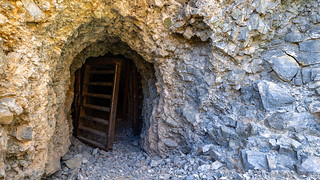
Open door policy.

I doubt that poster is original, but this internal head frame, named "Main Street" - used to hoist ore up from a lower level - was a cool find.
The Los Angeles Mine
Following the loop road for less than a mile - up to the top of the ridge - I was immediately in the midst of the Los Angeles Mine. I don't know much about this mine, except that it seemed to be a mid-sized operation, with a lot of foundations - mostly round, for tanks of some sort - littering the hillside. There were a few shafts - all now sealed by the BLM - on the property, one of which still had the remnants of an old headframe and ore chute rising up from the depths.

Lots of construction for relatively little production.
Ironically, Mike had been collecting ore at the various mines we'd visited, sure he was going to get rich when he eventually got around to processing it. Over the last few days, he'd picked up a half dozen brightly colored rocks - something that's totally allowed on BLM land - always wishing there'd be more. Should have stopped at the Los Angeles, Mike.

The ground was covered with this sparkly blue stuff. I left it there for Mike.

The most interesting aspect of the Los Angeles Mine for me was the view. I really wanted to call it an afternoon and camp here. Alas, it was only 3:30pm, so I pressed on.
The Murder Shaft
Before our trip, Mike - who seems to have 28 hours each day to research stuff, and search-fu that I could only dream of possessing - marked a spot with "Murder Shaft." Not wanting to press the issue - and hoping he wasn't secretly planning to acquire a new, 1st gen Tacoma at this location - I'd sort of just ignored it.

Seems safe.
Of course, the story turned out to be way more sinister. If you're curious then Secrets of a Marine's Wife might be a read that you'd enjoy. Or, for a summary, check out the excerpt of the ordeal.
Update 2023-03-30 - John Norman mentioned to me that he spent seven weeks on this search for Erin Corwin (the Marine's Wife) as part of the San Bernardino Cave and Technical Rescue Team. I was able to find a bit of information from that team regarding the search, which I thought would be interesting to share here.
This week we received a very nice note and an autographed copy of a new book. It's the story of the most extensive and difficult search the team has ever worked. On June 29, 2014 we we were called out to 29 Palms to assist in the search for 19 year-old Erin Corwin. Seven weeks later, we would find her murdered at the bottom of an abandoned mine known as "Site 108" on our search plan. This search covered hundreds of square miles, involved thousands of volunteer hours, and occupied several homicide detectives full-time.
After searching over 100 mines, her body was located on August 16th and recovered the next day. Conditions were extremely hazardous and a HAZMAT team from County Fire was needed to complete the recovery.
Her killer was brought to justice and is currently serving a sentence of life without parole. Without the dedication of so many, this case might remain unsolved.
Search & Rescue is run by volunteers and the SBSD Cave Team is one of the only teams in the United States equipped for missions in abandoned mines.

A nice note from author Shanna Hogan.

The last day of the search at Site 108. (left) | One of the mine sites near where Erin was located. (right)
The Moose Mine
Like the Murder Shaft, I didn't spend long at the Moose Mine, having stopped at it primarily because it was on the way to the next mine I planned to visit. It had a neat ore bin, but the adit was sealed about ten feet in. Plus, with the sun racing toward the horizon I figured it was time to start looking for camp.

It looked like the original ore bin had been in the wrong place or worn out, so they built another one right next to it.
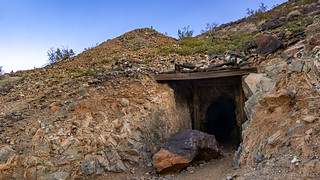
Don't mind the large rock, these adits are totally safe.
The Mission Mine
I pulled out of the Moose Mine just after 4:30pm, and made a beeline south. I mean really, Mike could have stuck around a couple more hours, since the entire route to this point would have been on his way home.
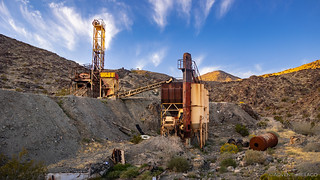
As I pulled up to the Mission Mine, it was certainly a more modern operation!
Discovered in either 1883 or 1887 by E. C. Huff of Los Angeles and George Lane of Mecca, the Mission Mine initially consisted of a 60 foot shaft (and drifts) sunk on the ore vain. A 20-ton ball mill and amalgamation plates were setup on the property, and water was piped in from a 600ft drop well nearby.
By 1930 the mine was leased to Messrs. Henderson, Foulkes, and Ake and the main shaft reached a depth of 570′ (with more than 600' of drifts). Milling was performed using a 10 ft arrastra - seemingly a step back from the original mill.
A decade later, E. C. Huff - still the owner - once again had the property under lease, this time to Mission Gold Mines, Inc. Development consisted of a 600 ft shaft, drifts, and a raise. Ore was being sent to the Gold Crown Mining Company's mill and averaged $43 a ton.
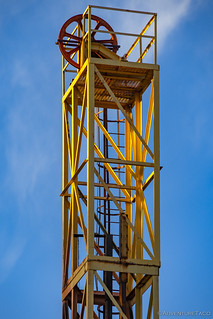
Ore was raised using this steel headframe. (left) | Then crushed and processed in the rest of the plant. (right)
The last major work took place in 1949 when a two-compartment shaft was dug to 600′ (with drifting at the 100-, 300-, 400-, and 600-foot levels) and operated by a 6HP gas engine. By this time, 5,000 - 10,000 tons of ore had been blocked out.
The last work at the Mission pushed the shaft to 650′ in 1981.
It is estimated the mine has over 280,000 ounces of gold in reserve. But even that - some $560M in 2023 - in gold is apparently not enough to overcome the bureaucracy of working underground and cleaning up a toxic site for today's miners.Linda Greene: Historic Resource Study A history of land use in Joshua Tree National Monument

Quite the operation.

Why use one wide belt when you can use ten narrow ones?
The Sunset Mine
One of the more famously photographed mines in the Dale Mining District, there was a nice fellow from Texas camped at the Sunset Mine when I arrived. His dinner - marinated steaks, some sort of grilled veggies, and who knows what else - smelled fabulous as I apologetically tried to stay out of his way while I snapped a quick photo of the only remaining building on the site.

It's probably obvious why this is a popular place - it's the clouds.
I'd see Texas guy again the following morning, when I'd get to tell him how great his dinner had smelled. For now though, the sun was already below the horizon and I needed to figure out what I was going to do for the night.

With light like this, it must be time for dinner.
The Golden Egg Mine
I must admit that my plan had been to head further south at this point - driving through the dark - to a trailhead that would take me to an arrastra and mine cabin when I awoke in the morning. It was only as I was verifying my route on the map that I noticed something I simply couldn't pass up.
Mike had marked a nearby mine as having an ore cart. And - as I've established - I am a sucker for ore carts.
Initially I figured it'd just a be a quick side trip to check out the cart - something I could do in darkness, given that I'd be using flashlights in the adit anyway - and then I'd continue with my southerly plans.

Lights on as I navigated the rock road down to the Golden Egg Mill.

This was quite the structure, though it was mostly just a shell at this point; the internals of the mill had been removed.
Knowing I had limited light, I quickly gathered up my camera gear, lights, and tablet and headed toward the dot marked "Ore cart adit." Oh boy, was I excited.

Carefully crafted stairs to a now empty room.
I was probably 100 feet past the mill when I spotted a carved out section of hillside that seemed to be in the right spot based on my GPS coordinates. Nearly jogging at this point, I reached the collar to find what appeared to be two levels of workings. I thought this a bit strange, but excitedly pressed into the lower workings.

The lower workings.
And then I stopped. Or rather, I was stopped. The relationship between the upper and lower workings was made clear as I discovered that the upper shaft had collapsed into the lower, completely blocking my path, and a reminder that these adits are totally, 100%, absolutely safe.
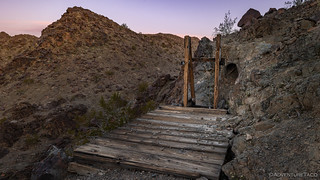
The deck and frame that used to be the entrance to the upper workings, the first 30 feet of which are now collapsed.
I was in shock. Could it be that this super-cool relic was no longer accessible for me to see? Mike had last been to this site some 7 years earlier, definitely long enough for some significant changes to take place in this part of the world known for its high levels of seismic activity.
Losing light quickly, I composed myself and realized that maybe the waypoint was in the wrong place. I'd already noticed that the old miners trail continued past this collar, so I followed it for several hundred more feet to its end - stopping at each small prospect pile along the way. Ultimately, none of the prospects were large enough to even have an adit, and I realized that I'd probably missed my opportunity to see an ore cart.
Sad Day. 
It was dark as I walked back to the truck. Glad that I'd brought along my headlamp and flashlight, I decided that my parking spot below the mill was a nice one, providing a fantastically framed view of the night sky to my south.
And so, rather than negotiate the narrow, rocky road that I'd descended in twilight an hour before, I opened up the tent and set about dinner preparations and consumption.

Mike had left a few of his signature LEDs for me to try out. These things are going to be dangerous.
After cleaning up, formulating a route for the next day, and transferring the photos I'd taken to my laptop - and with my already late arrival - it was a just after 10:00pm when I turned off the lights and settled down with my Kindle. I think I read about three screenfuls of Mitch Rapp - Oath of Loyalty before falling fast asleep.
I hadn't found the ore cart I was looking for, but I also hadn't left the mine where it allegedly existed.






Another great adventure, THANKS! As for the Mission Mine, you never know but with the increasing use/value of gold it could be reopened some day. A long closed mine just a few miles from me (The Golden Queen Mine, Soledad Mountain operation) was reopened and it currently being mined by a Canadian outfit. I also clearly remember the murder case of the young Marine wife, Erin Corwin, and the search for her, a very sad event.
Yes, many of these mines could be re-opened pending prices, I suppose. In fact, TWO of the mines in this latest story have seen recent activity (and a couple in the next part of the story as well!)
The mine we slept at - the Iron Age mine - is going to be reclaimed according to this story, but in the process they are going to re-process all of the tailings, some of which still contain more than 60% iron, and were discarded originally. Wow.
And, the Brooklyn Mine was recently re-registered and then sold to some wanna-be miners. I have no idea if they'll every actually work it, but theoretically there is still money to be made. ???
As for the murder - I don't remember ever hearing about it, but I have been trying to find a copy of the movie they made about it so I can watch it. Seems it was originally a Lifetime™ movie - not a channel I generally watch, and it seems that they no longer have it available for streaming... Ah, the days of DVD rentals, hahaha!
Glad you enjoyed the story; it's always so pleasant to read your comments!
Yes, the gold/silver mine here (I can see it from my backyard) is in full operation, they started by reprocessing the tailings and now heavy equipment is constantly moving the ore as they keep blasting. It's interesting, they have a huge grid laid out and do it in sections. There is another gold mine but it's about 40 miles from here and a much smaller underground operation. As for the murder story, it was big news here because of the location and the involvement of the Marine base at 29 Palms. I didn't know that someone made a movie about it. Since my friends and I often were out in the mines in San Bernardino County we were familiar with some of the areas being searched. We were glad when they finally caught the guy and put him in prison, still there I hear for the rest of his life. We've several more real life stories out here in the Mojave where people were killed and they bodies were dumped or buried. There are some very deep shafts here.
Fantastic documentation’s of historical mining operations and remains originating in the late 1800s-to early,mid and later 1900s before EPA restrictions and BLM obstructions made hard rock mineral extraction operations difficult if not impossible. Your mine safety advice is well taken!
Thanks Dave. It's a lot of fun researching the places to go, actually finding them, and then researching the history once I return and start putting the story together. Glad to hear you enjoyed it all!
Talk to John Norman. His team found the body.
Looks like a nice trip. I have camped out in the Dale several times over the last 30 or so years, the last time being about three years ago before moving out of CA for the last time. Lots of cool stuff out there and in the military surplus stores in 29 Palms. Lucerne Valley has a lot of old mining sites that are worth checking out as well.
I'll need to check out the Lucerne Valley... apparently besides DV and Mojave Preserve, I've really neglected the other parts of the SoCal desert. ?
The adventures, the pictures and the narrative just get better and better. Thanks for sharing your journey’s and good times.
Thanks Ken, glad you're enjoying! I had a lot of fun on this trip, and it's nice to hear that it's coming through in the retelling. ?
Do you know what 3M actually stands for? It's Minnesota MINING and Manufacturing. No idea if its actually they who owned this claimed though.
Great write up and pictures, this area is definitely one of the underappreciated places in the desert and I tell people going to Joshua Tree to spend some time there.
I had no idea that 3M stood for that, thanks for letting me know! (I actually tried to look it up when I got back from my trip, but I couldn't find anything and figured that it might have meant something at one time, but was now just "3M." Pretty funny that it's about mining, though this still - I'm sure, given the scale - wasn't one of their operations. ?
Great read!! I remember the story of the murder. Sad place to end up. The rest of the views in the area are something I want to visit! Thanks!!
Thank you for sharing! My husband and I feel like we are out and about jeepin!???
Awesome, glad you enjoyed it Debbie! That's exactly how I hope folks feel when they read one of my stories!
Mike @mk5 made this awesome animated gif that I'm just going to leave here for everyone to enjoy.
I've got camouflage.